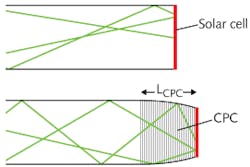Luminescent solar concentrators (LSCs) are slabs of transparent material containing a dye or other material that absorbs light at one wavelength and emits at another; the light collects via total internal reflection at the edges and is concentrated. Compound parabolic concentrators (CPCs) are nonimaging optics that maximally concentrate angularly spread incoming light. These two devices have been independently used to concentrate solar radiation; now, researchers at Pennsylvania State University (University Park, PA) are combining the two to boost the concentration ratio of LSCs.
At the moment existing only as a simulation, the design modeled by the researchers boosts the concentration ratio of the combined device (see figure, bottom) by 23% over that for the LSC alone (see figure, top), while maintaining greater than 90% of the original LSC’s optical efficiency. This is when applied to only a single edge of the LSC. If applied to all four edges of the LSC, the intensity is boosted by 35%, still maintaining greater than 90% of the original optical efficiency. The addition of the CPCs would allow smaller photovoltaic cells (the most expensive component of a luminescent solar concentrating system) to be used, while contributing only a small amount to manufacturing costs.
The researchers say that LSCs with highly directional luminescence in particular will benefit highly from the addition of CPCs. Contact Noel Chris Giebink at[email protected].
